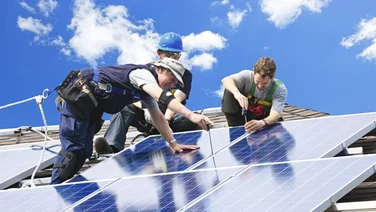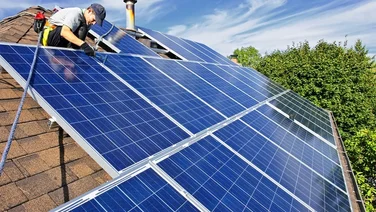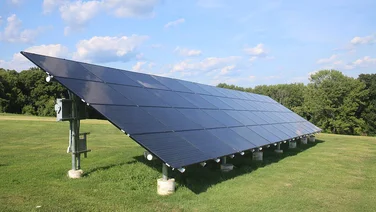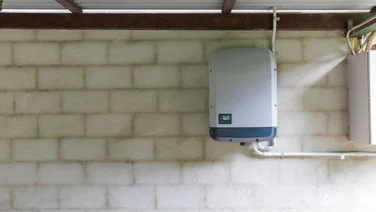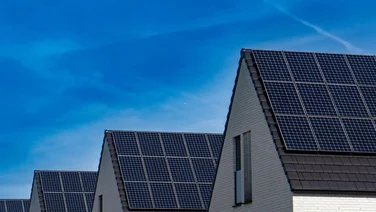✔ Monocrystalline panels are, on average, 36% more efficient than polycrystalline
✔ Polycrystalline panels typically cost 20% less than monocrystalline ones
✔ Monocrystalline solar panels are black, while polycrystalline panels are blue
The price of solar panels will often depend on a few key factors, including the type of panel you go for.
Monocrystalline and polycrystalline solar panels are the two most common types of panels used for residential installations. So you might be wondering what the differences are between these two panels, what they look like, and which type is best for your home.
We’ll answer all these questions, and more, in this article. We’ll also provide a breakdown of the average efficiency, power output, and lifespan of both monocrystalline and polycrystalline solar panels.
Want to speak to a professional solar panel installer? We can help. Just fill in this short form, and we’ll put you in touch with our network of certified installers, who’ll reach out to you with their best prices and expert advice.
Where do you want to install solar panels?
Get started
What’s the difference between monocrystalline and polycrystalline solar panels?
Monocrystalline and polycrystalline solar panels are both made using silicon solar cells, but they differ in terms of performance, appearance, and price.
We’ve summed up the key differences between the two in the following table:
Key Factors | Monocrystalline solar panels | Polycrystalline solar panels |
|---|---|---|
Average efficiency | 18%-24% | 13%-16% |
Cost | £350 per m² | £280 per m² |
Colour | Black | Dark blue |
Power output* | 175 W per m² | 125 W per m² |
Lifespan | 25-40 years | 25-35 years |
Temperature coefficient** | -0.3% / °C to -0.5% / °C | -0.3% / °C to -1% / °C |
* Estimated using a 350 watt (W), 2 m², monocrystalline panel as the basis for calculation
** A solar panel’s ‘temperature coefficient’ indicates by what percentage its efficiency drops by when the outside temperature goes above 25°C. The closer the percentage is to zero, the more heat resistant the panel is
What is a monocrystalline solar panel?
Monocrystalline solar panel cells are made from single-crystal silicon, which is cut into bars, and then square wafers that have rounded edges. These wafers have a black appearance to them, which tends to look more aesthetically pleasing than the blue hue you find in other panels.
Having a single-crystal structure means the electrons that produce electricity have more room to move around, making monocrystalline solar cells highly efficient.
This increased efficiency also means that monocrystalline panels can easily achieve a higher power output than polycrystalline panels, using fewer cells.
You can find out more about how efficient solar panels are by visiting our page.

A closer look at a monocrystalline solar panel on a the roof of a property
What is a polycrystalline solar panel?
Polycrystalline solar panel cells are made from silicon-crystal fragments, which are melted together and shaped into square wafers. The silicon-crystal fragments give polycrystalline panels a dark blue colour.
The use of silicon-crystal fragments, instead of single crystals, means that polycrystalline solar panels are cheaper than monocrystalline panels – but it also makes them less efficient. This is because the electricity-producing electrons have less room to move when there’s more than one silicon-crystal fragment in each solar cell.
You can find out more about different types of solar panels in our in-depth guide.

A closer look at a polycrystalline solar panel on the roof of a property
Where do you want to install solar panels?
Get startedMonocrystalline vs polycrystalline: which is better?
Monocrystalline solar panels tend to perform better than polycrystalline ones – they’re more efficient, which means they produce more electricity. However, polycrystalline panels are the more affordable option.
We’ll go into further detail about the costs, appearance, and performance of these two types of solar panels in the following sections.
Cost
Monocrystalline solar panels cost around 20% more than polycrystalline solar panels.
On average, monocrystalline solar panels cost £350 per square metre (m²), or £703 to buy and install a 350-watt (W) panel. Polycrystalline panels, on the other hand, cost around £280 per m², or £562 for a 350 W panel.
This is partly because producing single-crystal silicon – used in monocrystalline panels – is a long, complicated process. It also wastes more silicon than if manufacturers were to let the silicon crystals fragment.
You can find a more detailed breakdown of solar panel costs in our guide.
Efficiency
Monocrystalline solar panels tend to be more efficient than polycrystalline solar panels. On average, monocrystalline panels have an efficiency rating of 18% to 24%, whilst polycrystalline panels have a rating of 13% to 16%.
As we’ve mentioned further up, this is because the single-crystal silicon cells that make up monocrystalline panels are better at generating electricity than the silicon crystal fragments.
For a list of the most efficient solar panels on the market, head to our page.
Power output
Since monocrystalline solar panels are more efficient than polycrystalline ones, they produce more power per square foot. This means that monocrystalline panels can be more compact than polycrystalline panels, whilst having the same power output.
To illustrate, we’ll look at an example. Let’s say we have two solar panels: one is a 250 W polycrystalline panel, and the other is a 350 W monocrystalline panel. However, they are both 2 square metres in size.
So why this difference in power output, if the panels are the same size? Well, since the polycrystalline panel is around 36% less efficient than the monocrystalline panel, it’ll produce around 36% less power using the same surface area as the monocrystalline panel.
Appearance
Monocrystalline solar panel cells have a black appearance and a rounded square shape, whereas polycrystalline solar panel cells appear dark blue, clustered into a mosaic of sharp-edged squares.
Both types of panels can be paired with white, silver, or black backsheets (the supportive panel behind the solar cells), and can have frames that are either silver or black. Black backsheets and frames are popular to use with monocrystalline panels to create a fully black, sleek look.
Having aesthetic solar panels is an important factor. According to our National Home Energy Survey, two thirds of Brits already say they would buy a property with solar panels on it. And having attractive solar panels can make a sale even more likely.
Durability
Monocrystalline solar panels typically have a longer lifespan than polycrystalline solar panels, but only by a few years.
Both types of solar panels will last over 25 years – but monocrystalline panels can last up to 40 years, while polycrystalline panels can usually make it to 35 years.
The reason polycrystalline solar panels don’t last quite as long as monocrystalline panels is because they are made up of silicon-crystal fragments – instead of single-crystal silicon – which will separate over time, resulting in reduced efficiency.
Find out more about how long solar panels last, and what factors can affect their lifespan by visiting our guide.
Monocrystalline vs polycrystalline: which is right for you?
Deciding which solar panel is right for you will depend on your goals and limitations. But in most cases, monocrystalline solar panels will be a better option than polycrystalline ones.
And that’s simply because using single-crystal silicon in solar cells produces panels with higher efficiencies, lifespans, and better heat resistance than using silicon-crystal fragments. This is probably why the best solar panels on the market are usually monocrystalline.
So if you’re looking to invest in high-quality solar panels that will last up to 40 years, go with monocrystalline.
They’re also the better option for homeowners who have limited roof space. Monocrystalline solar panels have a higher power output per square metre than polycrystalline ones, so you can produce more electricity using less space.
But one caveat of monocrystalline solar panels is that they’re more expensive than polycrystalline solar panels. So if cost is a priority, polycrystalline solar panels might be the better option.
Regardless of what type of panel you choose, we’d recommend paying more upfront for quality. Cheap solar panels could cost you more in the long run since they’re more likely to break or stop working sooner than premium panels.
Are there any other types of solar panels?
There are several other types of solar panels, including monocrystalline and polycrystalline, although not all of them are available for homeowners.
One type that is available is thin-film solar panels. These are often used on boats, caravans, or buses, since they are lightweight and easily portable.
Transparent solar panels are also widely available, and are mostly used to replace windows or other glass structures. However, these panels have a very low efficiency rating, so you’d need a lot in order to produce the same amount of electricity as you would with regular solar panels.
The remaining types of solar panels include solar tiles, solar thermal panels – which generate heat, not electricity – concentrator photovoltaic (CPV) panels, and passivated emitter and rear contact (PERC) panels. There are also perovskite solar panels, but these are not commercially available yet.
Next steps
If you’re hesitating between monocrystalline and polycrystalline solar panels, it’s worth remembering that monocrystalline panels perform better overall. Their main downside is that they’re slightly more expensive than polycrystalline solar panels – but we think they’re worth the extra price.
Now that you know all about these two types of solar panels, you might want help finding someone who can install them for you, which is where we come in.
If you fill in our short form, we’ll pass your details on to expert solar panel installers who will get in touch with their best prices.
FAQs
Can you use polycrystalline and monocrystalline solar panels together?
Yes, you can technically use polycrystalline and monocrystalline solar panels together for the same property. However, it’s not common to do this – nor is it recommended, since it requires a more complicated electrical set up.
Since different panels usually won’t have identical electrical properties (such as voltage, current, power output, efficiency), they typically need to be wired using different cables. And wiring the panels incorrectly could damage the system, or reduce its electricity production.
What are the disadvantages of monocrystalline solar panels?
The main disadvantage of monocrystalline solar panels is that they are more expensive than other types of solar panels. The process of making them also wastes a lot of silicon, so they aren’t the most eco-friendly type of solar panel.
What is better than monocrystalline solar panels?
Monocrystalline solar panels are the best type on the market, so far. But it might not be in the future.
For example, in 2018 scientists at Oxford university developed a perovskite (a synthetic material) solar cell that had 28% efficiency. For context, the best monocrystalline solar panels so far are only 24% efficient.
But despite this innovation, solar panels made of perovskite cells aren’t yet being manufactured for commercial use.

